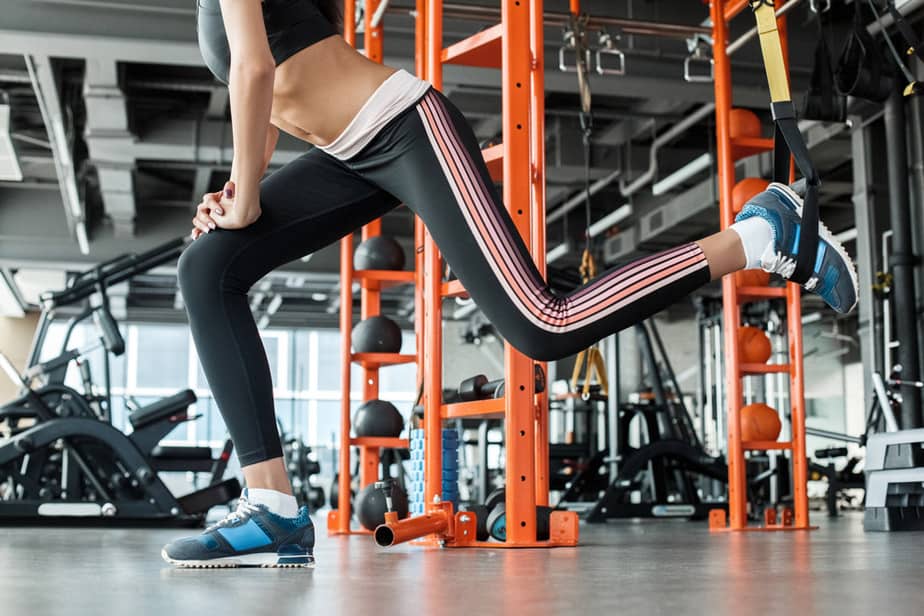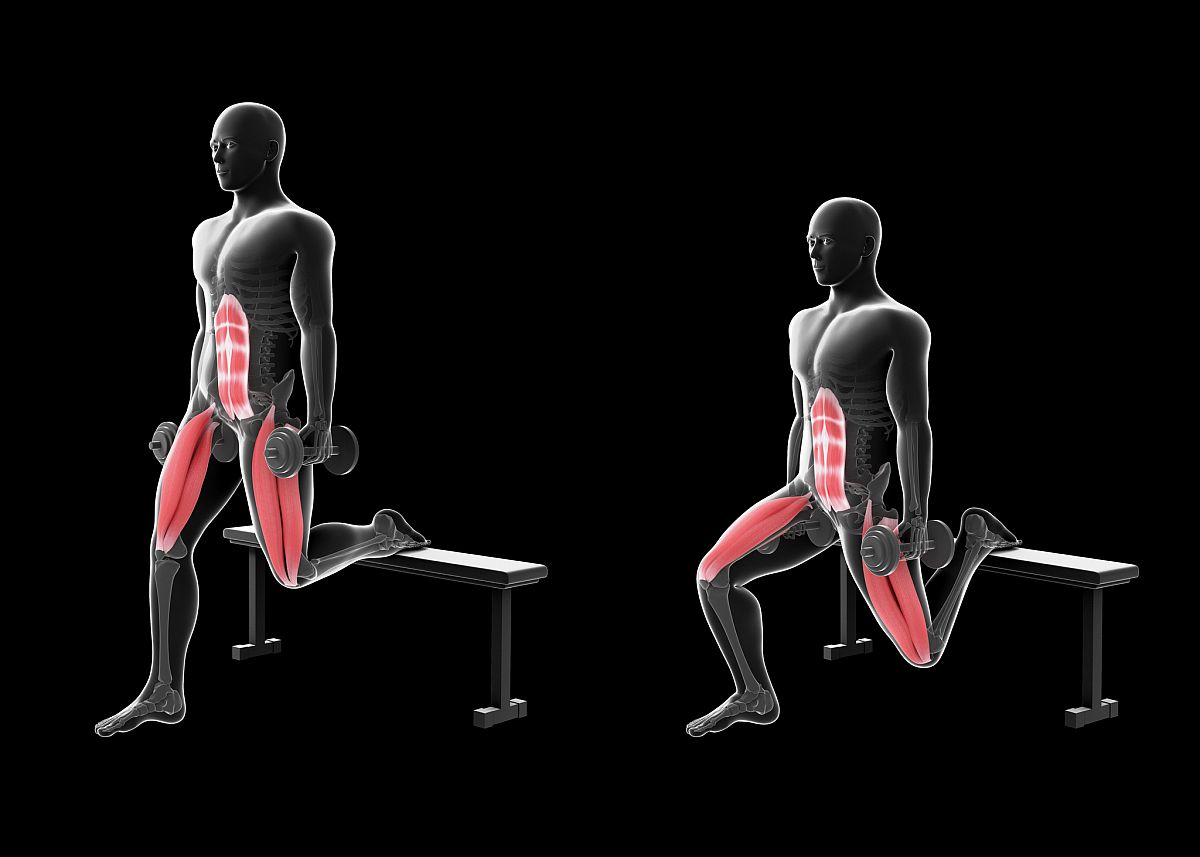Bulgarian weightlifters have long been renowned for their effective training and massive gains. The methodology is intense, pushing the body beyond its limit, with the belief that humans are more capable than they think.
In short, Bulgarian-style training is brutal and effective. In that way, the Bulgarian split squat lives up to its origins.

Up for a challenge? Read on to learn what Bulgarian split squats work, how to do them correctly, and everything else you need to know about this killer leg day workout.
What Is a Bulgarian Split Squat?
Bulgarian split squats are a unilateral, single-leg workout in which the back leg is elevated throughout the movement. You can do this squat variation with a barbell, dumbells, kettlebell, or bodyweight. In the gym, you’ll need a bench or box to elevate your back leg. If you’re trying to build muscle at home, you can get creative and use a couch or stack of books.
Once you feel comfortable with this exercise, you can also try a TRX cable or BOSU ball, using instability to increase muscle activation.
Unlike traditional squats, this unilateral movement shifts the focus to the quads and helps correct imbalances in the body.
Bulgarian Split Squat Muscles Worked

Bulgarian split squats are a compound movement that engages multiple muscle groups, including the glutes, quads, hamstrings, calves, and core. The glutes and quads are the primary movers, while the core helps stabilize your body as you maintain your balance.
Compound exercises are the best way to get the most out of your workout in the least amount of time. Whether you’re a bodybuilder looking to target your quads and glutes or a powerlifter aiming to hit a new barbell squat PR, you’ll want Bulgarian split squats in your repertoire.
What are Bulgarian Split Squats Good for?
Split squats and other unilateral exercises are great for improving muscle activation and build a bigger barbell squat. It’s hard to identify poor muscle activation and compensations in ourselves. A skilled trainer or coach with education in functional movement patterns can help, but that’s not always an option.
Consider this: your dominant side (indicated by your leading hand) tends to be stronger than the other side of your body. If you’re doing a barbell squat with a moderate muscle imbalance, your dominant side will pick up the slack. As a result, your stronger side gets stronger, and your weaker side progresses much slower.
Over time, these subtle shifts from one side to another could lead to an injury while lifting.
Unilateral exercises, like the Bulgarian split squat, force that weak side to get stronger and match up with your dominant side. In essence, you improve your balance and strength while preventing injuries.

How to Do Bulgarian Split Squats Correctly
Proper form is essential for any weight-bearing exercise, and Bulgarian split squats are no exception. Generally, those who worry about knee pain or other injuries from this advanced movement can avoid those issues with proper form and control.
Here’s how to do a Bulgarian split squat correctly:
- Set up your bench or base at approximately knee height. You may need to adjust this based on your mobility and unique body mechanics.
- Stand a few feet in front of the bench with your front foot planted and your back foot elevated. Your front foot should be far enough away so your back knee doesn’t touch the ground when you squat.
- Brace your core, and sink your body straight down, allowing your front knee to bend forward as your back knee bends toward the floor. This movement should be slow and controlled.
- Stop at the end of your range of motion. Your torso should be upright, and your front foot flat on the floor.
- Pause at the bottom of the squat, then drive upward through the front foot until you reach starting position. That’s one rep.
- Complete all reps on one side before switching to the other.
Controlling your speed through the eccentric (downward) portion of the exercise is the key to success with Bulgarian split squats. Your front knee should be at hip-width the entire time; watch for caving and correct it by activating the glutes.
Bulgarian Split Squat FAQs
If you’re new to Bulgarian split squats, the movement can be intimidating. While it’s normal to wobble and have to adjust your stance a few times when you get started, there’s always room to improve.
Here are some frequently asked questions about Bulgarian split squats and all the answers to get you started on the right (or left) foot.
How many times a week should I do Bulgarian Split Squats?
The frequency of your Bulgarian split squats will depend on your overall training plan and goals. If you train five days a week with multiple lower-body days, there’s no harm in doing Bulgarian split squats twice per week.
If you only train a few days a week, it’s beneficial to swap out your split squats one day for something that targets other lower body muscles as primary movers, like using Romanian deadlifts to hit the hamstrings.
Listen to your body and adjust as needed, ensuring adequate time for rest and regeneration between muscle groups.
Are Bulgarian split squats bad for knees?
There’s a lot of misinformation about squatting and hurting your knees. If you have a pre-existing knee injury, you should always consult a professional and be mindful of how you feel during lower body exercises.
It’s also a myth that extending your knees over your toes is a bad thing, which stems from a study dating back to the 1970s. If you do Bulgarian split squats with proper form while following functional movement patterns (i.e., not cheating your reps or letting your ego push the weight), you should be fine.
If you experience knee pain, step forward and adjust your stance. If you still feel pain, stop the movement and consult a professional.
How are Bulgarian split squats different from lunges?
If you’ve watched a video of split squats and said, “Hey, that’s a lunge!” you’re not alone. The difference between lunges and split squats is subtle.
With a lunge, the back leg is actively in motion throughout the movement. With the split squat, the back leg is passive, acting as a stabilizer. In other words, lunges are dynamic, and split squats— whether elevated in Bulgarian style or on the floor— are static.
Are split squats better than lunges?
When it comes to lunges vs. split squats, one is no better than the other; they’re just different. While both are compound movements that engage the hips and core as stabilizers, split squats shift the focus to the quadriceps. Lunges, on the other hand, are more balanced across the lower body muscle groups.
Which leg does a Bulgarian split squat work?
While they are a unilateral exercise, Bulgarian split squats do work both legs— just one more than the other. The quad of your front leg is bearing the concentric (upward) movement load, but your back leg and glute are also firing up throughout.
Where are you supposed to feel Bulgarian split squats?
You’ll generally feel the weight in your front leg, with your quads and glutes feeling the burn. You’ll likely also feel the stretch in your hip flexors if your mobility is limited; it’s important not to push this stretch and ease into a deeper range of motion.
Should I go heavy Bulgarian split squats?
It’s always wise to start light with Bulgarian split squats. You should work on getting the movement and form down before adding weight. Typically, Bulgarian split squats will be lighter than other squat variations.
Final Thoughts on Bulgarian Split Squats
Bulgarian split squats are an excellent way to take your leg day training to the next level.
Use this exercise to correct muscle imbalances, target your quads, train your core, and improve your lower body strength.
Remember to take it slow and scale up over time.